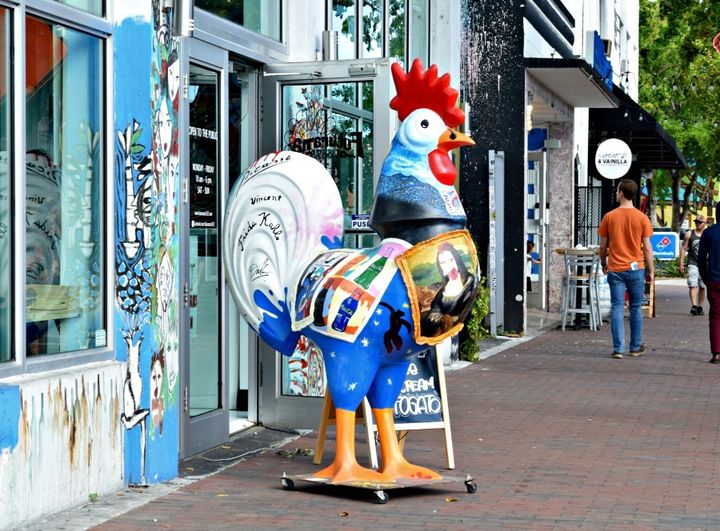There are many shades to colors. I hear that there are fifty shades of grey. Imagine. I have been toying with the idea of writing about the shades of meaning that colors have in different languages. Hugh Rawson, the late lexicographer at the OED, and a friend, spurred my old interest in the subject with his post “Five shades of grey? Colors and their connotations” which I recommend. This essay about colors in English proves that grey and blue go beyond a simple description of what the dictionary defines, in a rather complicated way, as “the quality of an object or substance with respect to light reflected by the object, usually determined visually by measurement of hue, saturation, and brightness of the reflected light; saturation or chroma; hue.” There, suck on that!

Colors in Calle Ocho in Miami
We know that grass is green (except in Kentucky), the sky is blue, cats are grey in the dark, flames are orange, roses are red (except when they are not), violets are blue -according to Mother Goose-, and this gives us a false sense of security and simplicity. Languages and words, colors in this case, are not that simple.
Language uses colors for its own purposes, attaching diverse and odd meanings to them. This versatility makes language acquisition harder than the mere grammatical rules which are, after all, easy to acquire. I have, you have, he has, tengo, tienes, tiene is no problem compared to what comes next: the lexical and phraseological hurdles and potholes ahead. We learn “red,” rojo, rouge, roig, rot… not suspecting the many different meanings that word may have in itself or in phraseology in Spanish, French, Catalan, German…
The primary colors are three: red, green and blue and out of these we get yellow, orange, brown, purple, grey, violet, pink, white… black does not emit or reflect light. Colors in paints are now labeled with numbers. Green 100 is not the same as Green 101, and certainly not the same as Green 102… although we may not perceive the difference with the naked eye.
Red / rojo, will do for our research of today. The word is associated with violence, passion, love, fiery heat, excitement, energy. The woman in red, la mujer de rojo, red lips, labios rojos.
Red is, in informal English, red wine, a glass of red, which in Spanish corresponds to tinto, red wine. So never say deme un vaso de vino rojo, but vino tinto, as opposed to vino blanco, white wine.
“A red,” as a noun, is a communist, un rojo. Both words have the same meaning, from the Bolshevik revolution which adopted the red flag, although the association of red with blood and violence is very old. For the Franco dictatorship los rojos were the bogeymen of the regime.
Rojo is a rather common and old Spanish surname which has its equivalents in English as Reid, Read, Redd, Reade and Red, possibly of Scottish origin. Etymologically, perhaps because of redheads, pelirrojos, but this may not be so.
Some like red meat, carne roja and when drinking wine some go red as a beet, rojos como un tomate, a simile that uses different terms: beet in English and tomate in Spanish.
Al rojo vivo, when a metal is very hot, has its English equivalent in “red hot,” just as “red or hot blooded” turns out as sangre caliente. Also rojo blanco, “red white.”
Números rojos is a borrowing from the English “in the red”, when our bank account has reached a minus figure, from the old practice of using red ink to denote debt or loss in bookkeeping, which can also be tener la cuenta en descubierto.
The native inhabitants of America were called “redskins” or pieles rojas, a term borrowed from English. Skin color has been prominent in defining races, like white race, yellow race, black race.
“To paint the town red”, to celebrate boisterously, has no Spanish equivalent using the term red. Learners of English might take these expressions literally. Appearances are deceiving in language learning. So, beware.
Ponerse rojo, “to go red,” to blush, to be embarrassed, has another expression akin to it: rojo de ira, “to see red,” to become enraged.
“Red-light district,” “red-letter day,” “red tape”, “red-handed,” … do have Spanish equivalents –at least in Peninsular Spanish- but without rojo in them: Barrio chino, día feriado, papeleo, burocracia, con las manos en la masa…
And of course we have The Red Cross, la Cruz Roja, Rotes Kreuz, Creu Roja, Croix Rouge. The Red Sea, el Mar Rojo… and more.
The above does not apply if you are color blind, daltónico or daltoniano, and live in a black-and-white world as in the old movies.
